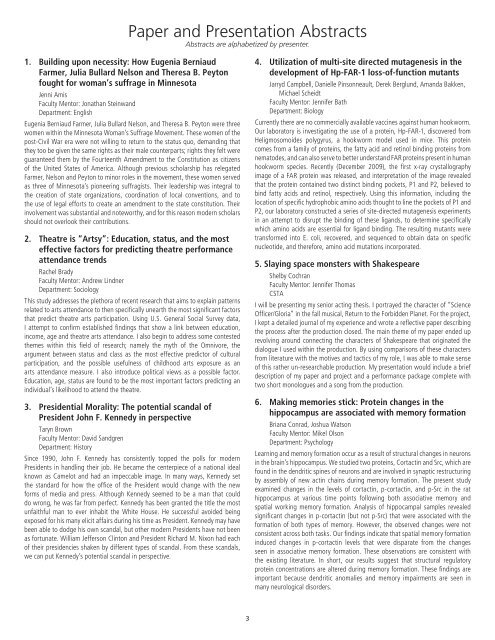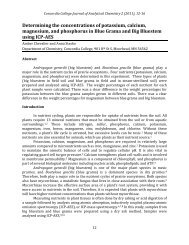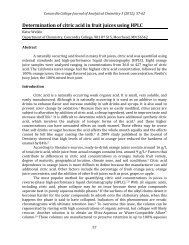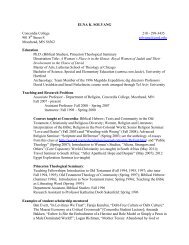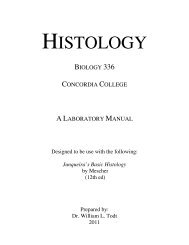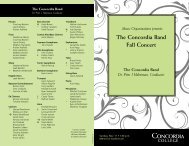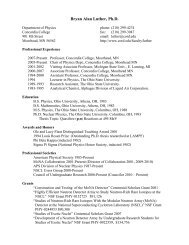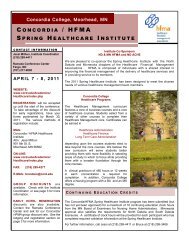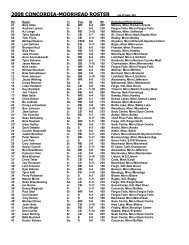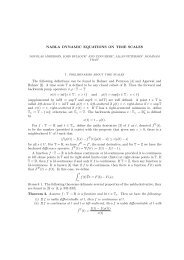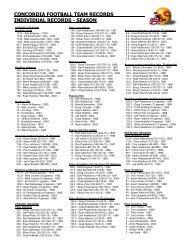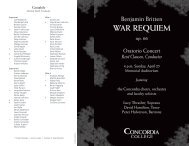Celebration of Student Scholarship - Concordia College
Celebration of Student Scholarship - Concordia College
Celebration of Student Scholarship - Concordia College
You also want an ePaper? Increase the reach of your titles
YUMPU automatically turns print PDFs into web optimized ePapers that Google loves.
1. Building upon necessity: How Eugenia Berniaud<br />
Farmer, Julia Bullard Nelson and Theresa B. Peyton<br />
fought for woman’s suffrage in Minnesota<br />
Jenni Amis<br />
Faculty Mentor: Jonathan Steinwand<br />
Department: English<br />
Eugenia Berniaud Farmer, Julia Bullard Nelson, and Theresa B. Peyton were three<br />
women within the Minnesota Woman’s Suffrage Movement. These women <strong>of</strong> the<br />
post-Civil War era were not willing to return to the status quo, demanding that<br />
they too be given the same rights as their male counterparts; rights they felt were<br />
guaranteed them by the Fourteenth Amendment to the Constitution as citizens<br />
<strong>of</strong> the United States <strong>of</strong> America. Although previous scholarship has relegated<br />
Farmer, Nelson and Peyton to minor roles in the movement, these women served<br />
as three <strong>of</strong> Minnesota’s pioneering suffragists. Their leadership was integral to<br />
the creation <strong>of</strong> state organizations, coordination <strong>of</strong> local conventions, and to<br />
the use <strong>of</strong> legal efforts to create an amendment to the state constitution. Their<br />
involvement was substantial and noteworthy, and for this reason modern scholars<br />
should not overlook their contributions.<br />
2. Theatre is “Artsy”: Education, status, and the most<br />
effective factors for predicting theatre performance<br />
attendance trends<br />
Rachel Brady<br />
Faculty Mentor: Andrew Lindner<br />
Department: Sociology<br />
This study addresses the plethora <strong>of</strong> recent research that aims to explain patterns<br />
related to arts attendance to then specifically unearth the most significant factors<br />
that predict theatre arts participation. Using U.S. General Social Survey data,<br />
I attempt to confirm established findings that show a link between education,<br />
income, age and theatre arts attendance. I also begin to address some contested<br />
themes within this field <strong>of</strong> research; namely the myth <strong>of</strong> the Omnivore, the<br />
argument between status and class as the most effective predictor <strong>of</strong> cultural<br />
participation, and the possible usefulness <strong>of</strong> childhood arts exposure as an<br />
arts attendance measure. I also introduce political views as a possible factor.<br />
Education, age, status are found to be the most important factors predicting an<br />
individual’s likelihood to attend the theatre.<br />
3. Presidential Morality: The potential scandal <strong>of</strong><br />
President John F. Kennedy in perspective<br />
Taryn Brown<br />
Faculty Mentor: David Sandgren<br />
Department: History<br />
Paper and Presentation Abstracts<br />
Abstracts are alphabetized by presenter.<br />
Since 1990, John F. Kennedy has consistently topped the polls for modern<br />
Presidents in handling their job. He became the centerpiece <strong>of</strong> a national ideal<br />
known as Camelot and had an impeccable image. In many ways, Kennedy set<br />
the standard for how the <strong>of</strong>fice <strong>of</strong> the President would change with the new<br />
forms <strong>of</strong> media and press. Although Kennedy seemed to be a man that could<br />
do wrong, he was far from perfect. Kennedy has been granted the title the most<br />
unfaithful man to ever inhabit the White House. He successful avoided being<br />
exposed for his many elicit affairs during his time as President. Kennedy may have<br />
been able to dodge his own scandal, but other modern Presidents have not been<br />
as fortunate. William Jefferson Clinton and President Richard M. Nixon had each<br />
<strong>of</strong> their presidencies shaken by different types <strong>of</strong> scandal. From these scandals,<br />
we can put Kennedy’s potential scandal in perspective.<br />
3<br />
4. Utilization <strong>of</strong> multi-site directed mutagenesis in the<br />
development <strong>of</strong> Hp-FAR-1 loss-<strong>of</strong>-function mutants<br />
Jarryd Campbell, Danielle Pinsonneault, Derek Berglund, Amanda Bakken,<br />
Michael Scheidt<br />
Faculty Mentor: Jennifer Bath<br />
Department: Biology<br />
Currently there are no commercially available vaccines against human hookworm.<br />
Our laboratory is investigating the use <strong>of</strong> a protein, Hp-FAR-1, discovered from<br />
Heligmosomoides polygyrus, a hookworm model used in mice. This protein<br />
comes from a family <strong>of</strong> proteins, the fatty acid and retinol binding proteins from<br />
nematodes, and can also serve to better understand FAR proteins present in human<br />
hookworm species. Recently (December 2009), the first x-ray crystallography<br />
image <strong>of</strong> a FAR protein was released, and interpretation <strong>of</strong> the image revealed<br />
that the protein contained two distinct binding pockets, P1 and P2, believed to<br />
bind fatty acids and retinol, respectively. Using this information, including the<br />
location <strong>of</strong> specific hydrophobic amino acids thought to line the pockets <strong>of</strong> P1 and<br />
P2, our laboratory constructed a series <strong>of</strong> site-directed mutagenesis experiments<br />
in an attempt to disrupt the binding <strong>of</strong> these ligands, to determine specifically<br />
which amino acids are essential for ligand binding. The resulting mutants were<br />
transformed into E. coli, recovered, and sequenced to obtain data on specific<br />
nucleotide, and therefore, amino acid mutations incorporated.<br />
5. Slaying space monsters with Shakespeare<br />
Shelby Cochran<br />
Faculty Mentor: Jennifer Thomas<br />
CSTA<br />
I will be presenting my senior acting thesis. I portrayed the character <strong>of</strong> “Science<br />
Officer/Gloria” in the fall musical, Return to the Forbidden Planet. For the project,<br />
I kept a detailed journal <strong>of</strong> my experience and wrote a reflective paper describing<br />
the process after the production closed. The main theme <strong>of</strong> my paper ended up<br />
revolving around connecting the characters <strong>of</strong> Shakespeare that originated the<br />
dialogue I used within the production. By using comparisons <strong>of</strong> these characters<br />
from literature with the motives and tactics <strong>of</strong> my role, I was able to make sense<br />
<strong>of</strong> this rather un-researchable production. My presentation would include a brief<br />
description <strong>of</strong> my paper and project and a performance package complete with<br />
two short monologues and a song from the production.<br />
6. Making memories stick: Protein changes in the<br />
hippocampus are associated with memory formation<br />
Briana Conrad, Joshua Watson<br />
Faculty Mentor: Mikel Olson<br />
Department: Psychology<br />
Learning and memory formation occur as a result <strong>of</strong> structural changes in neurons<br />
in the brain’s hippocampus. We studied two proteins, Cortactin and Src, which are<br />
found in the dendritic spines <strong>of</strong> neurons and are involved in synaptic restructuring<br />
by assembly <strong>of</strong> new actin chains during memory formation. The present study<br />
examined changes in the levels <strong>of</strong> cortactin, p-cortactin, and p-Src in the rat<br />
hippocampus at various time points following both associative memory and<br />
spatial working memory formation. Analysis <strong>of</strong> hippocampal samples revealed<br />
significant changes in p-cortactin (but not p-Src) that were associated with the<br />
formation <strong>of</strong> both types <strong>of</strong> memory. However, the observed changes were not<br />
consistent across both tasks. Our findings indicate that spatial memory formation<br />
induced changes in p-cortactin levels that were disparate from the changes<br />
seen in associative memory formation. These observations are consistent with<br />
the existing literature. In short, our results suggest that structural regulatory<br />
protein concentrations are altered during memory formation. These findings are<br />
important because dendritic anomalies and memory impairments are seen in<br />
many neurological disorders.


